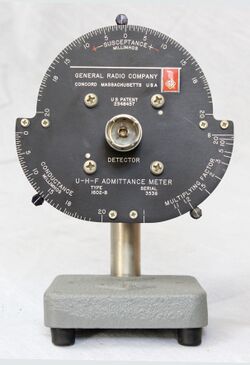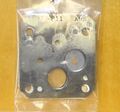1602-B: Difference between revisions
No edit summary |
(→Links) |
||
| (14 intermediate revisions by 2 users not shown) | |||
| Line 1: | Line 1: | ||
{{GR Product | {{GR Product | ||
|model=1602-B | |model=1602-B | ||
|codes=HONEY,1602-9702 | |||
|class=impedance measurement | |class=impedance measurement | ||
|summary= | |summary=UHF admittance meter | ||
|image=GR 1602-B Front Close-Up.jpg | |image=GR 1602-B Front Close-Up.jpg | ||
|caption=General Radio 1602-B UHF Admittance Meter | |caption=General Radio 1602-B UHF Admittance Meter | ||
| Line 11: | Line 12: | ||
|manuals= | |manuals= | ||
* [[Media:GRwiki 1602-B Amitance Meter 1602-0110-J 1968.pdf|General Radio 1602-B Admittance Meter Manual 1602-0110-J 1968]] | * [[Media:GRwiki 1602-B Amitance Meter 1602-0110-J 1968.pdf|General Radio 1602-B Admittance Meter Manual 1602-0110-J 1968]] | ||
{{Catalog History}} | |||
}} | }} | ||
The | The {{Title|General Radio 1602-B UHF Admittance Meter}} was introduced in {{Catalog M}} and remained available through {{Catalog 1978}}. | ||
The Type 1602-B is a null type instrument designed to measure admittance at UHF frequencies with coaxial systems. It | The Type 1602-B is a null type instrument designed to measure admittance at UHF frequencies with coaxial systems. It achieves this by the use of three loops parallel connected to the detector. The three loops are coupled magnetically to the unknown admittance, conductance standard and susceptance standard lines which are driven directly by the generator. By adjusting these loops for a minimum (null) at the detector, a direct reading from the three scales is determined. | ||
The 1602-B is an update from the [[1602-A]] with an expanded "Multiplying Scale" and locking coaxial connectors. Supplied with the instrument are two multiplier plates that improve accuracy, resolution and range. The susceptance scale is direct-reading only with matched serial numbered susceptance standards supplied with the instrument. | |||
==Specifications== | ==Specifications== | ||
'''RANGES OF MEASUREMENT''' | |||
* '''Conductance:''' 0.01 to 4000 | * '''Conductance:''' 0.01 to 4000 mS | ||
* '''Susceptance:''' -4000 to +4000 | * '''Susceptance:''' -4000 to +4000 mS | ||
* '''Frequency:''' 40 to 1500 MHz, direct reading. | * '''Frequency:''' 40 to 1500 MHz, direct reading. | ||
* '''Accuracy (conductance and susceptance):''' Up to 1000 MHz, from 0 to 20 | * '''Accuracy (conductance and susceptance):''' Up to 1000 MHz, from 0 to 20 mS, + (3% ± 0.2 mS) from 20 to 00 mS, +(3 √M% + 0.2 mS) where M is the scale-multiplying factor. | ||
==Links== | ==Links== | ||
* [[Media:GR Exp 1602-A 05_1950.pdf|Experimenter describing Type 1602-A May 1950]] | |||
* [[Media:GR Exp 1602-B 08_1953.pdf|Experimenter describing Type 1602-B August 1953]] | |||
* [[Media:GR Exp 1602-B 05_1960.pdf|Experimenter describing Type 1602-B May 1960]] | * [[Media:GR Exp 1602-B 05_1960.pdf|Experimenter describing Type 1602-B May 1960]] | ||
* [[Media: | * [[Media:Handbook of Coaxial Microwave Measurements.pdf|Handbook of Coaxial Microwave Measurements]] | ||
==Photos== | ==Photos== | ||
Latest revision as of 03:15, 30 May 2024
The General Radio 1602-B UHF Admittance Meter was introduced in Catalog M (1951) and remained available through Catalog 1978.
The Type 1602-B is a null type instrument designed to measure admittance at UHF frequencies with coaxial systems. It achieves this by the use of three loops parallel connected to the detector. The three loops are coupled magnetically to the unknown admittance, conductance standard and susceptance standard lines which are driven directly by the generator. By adjusting these loops for a minimum (null) at the detector, a direct reading from the three scales is determined.
The 1602-B is an update from the 1602-A with an expanded "Multiplying Scale" and locking coaxial connectors. Supplied with the instrument are two multiplier plates that improve accuracy, resolution and range. The susceptance scale is direct-reading only with matched serial numbered susceptance standards supplied with the instrument.
Specifications
RANGES OF MEASUREMENT
- Conductance: 0.01 to 4000 mS
- Susceptance: -4000 to +4000 mS
- Frequency: 40 to 1500 MHz, direct reading.
- Accuracy (conductance and susceptance): Up to 1000 MHz, from 0 to 20 mS, + (3% ± 0.2 mS) from 20 to 00 mS, +(3 √M% + 0.2 mS) where M is the scale-multiplying factor.
Links
- Experimenter describing Type 1602-A May 1950
- Experimenter describing Type 1602-B August 1953
- Experimenter describing Type 1602-B May 1960
- Handbook of Coaxial Microwave Measurements
Photos
-
-
-
-
-
-
-
-
-
-
-
Supplied Accessories
-
Multiplier Plates












